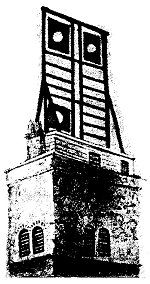Dunstable
Signalling Station
Places > Dunstable > Dunstable Downs > Signalling Station
by Omer Roucoux
Previous Page | Page 4
The drawings of the St Albans signalling station (below), also by George Shepherd, show many variations . This one has also 18 small sections working in groups of three to form six shutters, but the closed shutters do not show that they are made of smaller sections, they don't have pivoting axes and are square with a hole in the middle which seems unlikely as this would have made them less visible. None of the pictures I have seen are completely accurate having been probably drawn from memory.

Interpretation of the St Albans signalling station on top of the clock tower near the market.
As can be seen on the map (page 3) the signals arrived at Dunstable Downs from St Albans. The frame there was situated on the well-known clock tower near the market. It was at an altitude of 94 m (310 ft) above sea level. Although the frame was placed askew, from one corner of the narrow flat roof to the other, the position must have been cramped for the operators, who were presumably crowded into the room immediately below. There was the consolation that they were in the heart of a busy town and not on an isolated hill. The tower is nowadays not visible from Dunstable Downs because of the vegetation.
Dunstable station was on the Downs, 18.5 km (11.3 miles from St Albans, at an altitude of 214 m (796 ft). The next station was at a distance of 14 km (9 miles) It was on top of Telegraph Hill at Liley Hoo, a mile north of Lilley village, next to the Icknield Way footpath. This hill can be seen from the Downs beyond the Marsh Farm high-rise buildings. It must have been quite an accomplishment to read the panels at that distance. It would be approximately like reading the model above (scale 1/30) from about 500 m. or 1/3 of a mile away. Good quality telescopes that could magnify at least 20 times were in use by the Navy at the time. Using one would be equivalent to looking at our model (fig. 7) (7 x 12 cm) from a distance of 25 metres (75 feet).
The main problem was not actually the distance, one can actually see Aylesbury County Hall, with the naked eye, from the Downs in clear weather and that is 20 km (32 miles) away. The main problem was the weather since the smoke, in London, was often a problem and there was fog everywhere. Some years the system could only be used on one day out of three.
Bibliography:
- The Old Telegraphs by Geoffrey Wilson (Phillimore, 1976)
Page last updated: 23rd January 2014
